Rainbowfish are members of the family Melanotaeniidae and are not quite as common at your local fish store compared to other species. This is a shame because these fish species really do live up to their name! Rainbow fish are bright and fast-moving schooling fish that are not difficult to care for. They make a great addition to any spacious fish tank.
So let’s take a look at the 19 best Rainbow Fish tank mates you can choose for rainbow fish!
19 Of The Best Rainbow Fish Tankmates
These active fish species get along well with a wide number of tank mates. So long as they are similar in size and habit, rainbow fish are some of the least troublesome community tank residents you can buy!
1. Mollies
Number one on our list is the Molly fish. These hearty livebearers are from Mexico and Central America. Like Guppies, they are extremely easy to breed and are robust, peaceful aquarium fish.
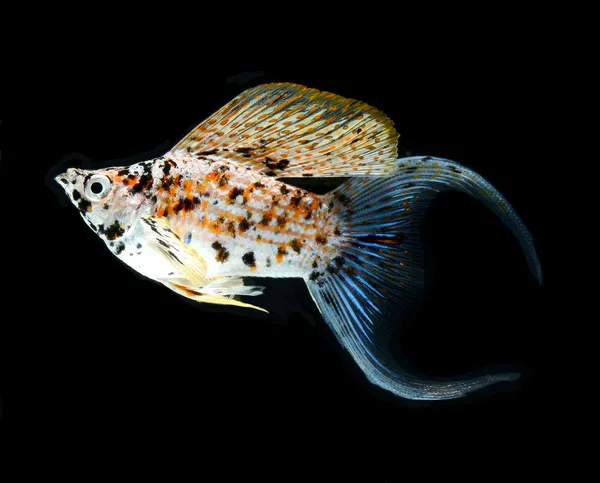
Mollies enjoy hard, alkaline water quality – but fortunately, so do many rainbow fish. Most Mollies also need a touch of aquarium salt to survive since, in their natural habitat, they live in brackish and coastal waters.
2. Guppies
Guppies are also known as Million Fish because you are pretty much guaranteed to have babies if you own more than one. All pet stores carry Guppies because they are a favorite of aquarists of all skill levels. They come in a wide range of colors and fin shapes as well, including fantail, blue tuxedo, green snakeskin, and more.
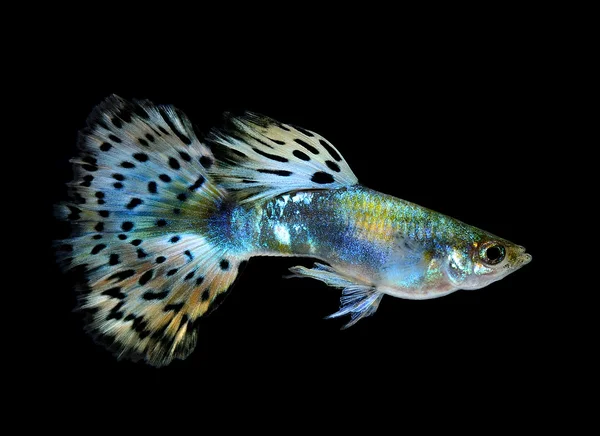
Guppies are not especially long-lived fish; 2 to 3 years is average for them. But their babies will carry on in your aquariums, as will their grand-babies!
3. Giant Danios
Most Danios are on the smaller side. Zebra Danios, Celestial Pearl Danios, and other species are also good rainbow fish tank mates but can be intimidated by larger varieties. If you are keeping Red Irian Jaya or Bosemani Rainbow Fish, then you should consider Giant Danios (Devario aequipinnatus) instead.
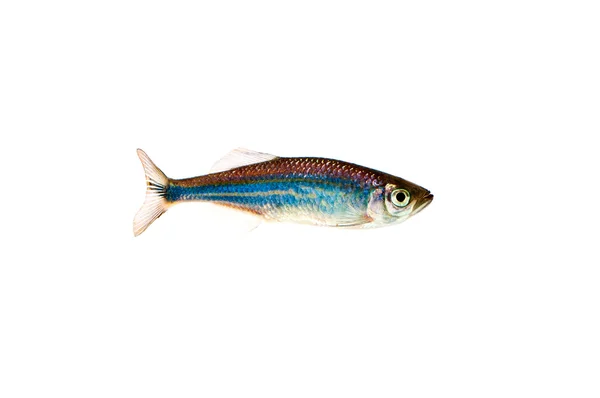
At 4 to 6 inches, they are similarly sized to an adult male rainbowfish. They also prefer similar water conditions and are also schooling fish and egg scatterers. Giant Danios can be a little nippy towards each other, smaller species of fish, and any long-finned fish species in the tank. So choose tankmates carefully.
4. Dwarf Cichlids
Dwarf cichlid is something of a bucket category that includes a huge number of fish from all over the world. Any cichlid under 4 inches long could be considered a dwarf cichlid.

Most – but not all – dwarf cichlids are more peaceful than their larger cousins. Their size limits their ability to dig or cause harm to live plants. However, they do become aggressive when they find good spawning sites and once they start defending their eggs and fry. Fortunately, rainbow fish are fast-moving midwater dwellers and will easily be able to avoid an ornery pair of dwarf cichlids!
5. Barbs
“Barb” is another large category of fish that includes an assortment of cyprinids found in Southeast Asia. Cyprinids also include Danios, Goldfish, Koi, and Carp. Barbs tend to be fast-moving, schooling, and omnivorous, feeding on both plant and animal matter.
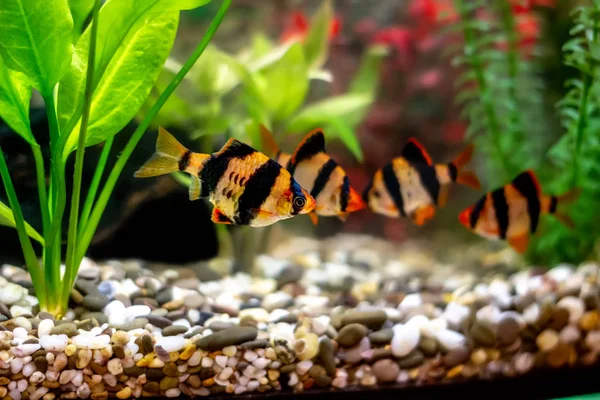
They share the same natural environment as rainbow fish as well, making them excellent tank mate choices. Smaller barbs tend to be the most peaceful, and the Cherry Barb is one of the best. Medium size barbs like the Tiger Barb also work well though they will nip at frayed fins of slower-moving tank mates.
6. Peacock Cichlids
Many species of African Cichlid can be hard to match with other fish species. But Peacock Cichlids are a rare exception. Despite being medium-sized (4 to 6 inches), they are fairly non-aggressive cichlids, spending most of their time sifting the sand for invertebrates. When breeding, they can be temperamental, but even then, they are fairly tame.

Rainbow fish make excellent midwater swimmers that are just as colorful but too large to be eaten. Most species will also thrive in the alkaline water and warmer water temperature that peacock cichlids require!
7. Platies
Platies are yet another livebearer that gets along well with other fish, including rainbow fish. Platies are in between Guppies and Mollies in terms of size. However, they combine many of the best traits of the two fish.
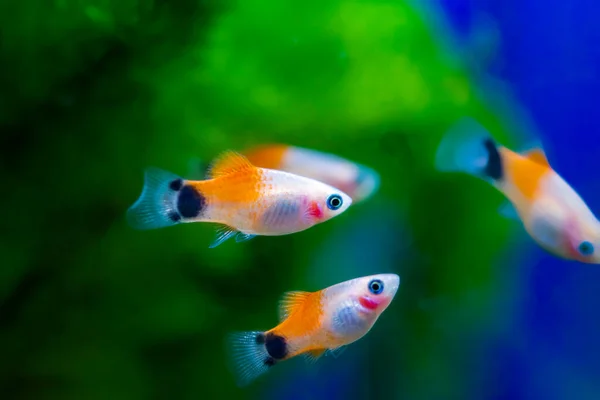
Platies come in a huge assortment of colors and patterns. And being omnivorous, they will eat everything from algae and prepared fish flakes to blood worms and brine shrimp. Just be prepared for loads of baby fish to rehome because these livebearers breed like crazy!
8. Suckermouth Catfish
Suckermouth Catfish (or Plecostomus) are a group of South American catfish that specialize in eating algae and biofilms from hard surfaces. Their love for algae makes them a favorite of fish keepers. But be aware that most of these fish grow quite large and won’t find enough algae in a home aquarium to last them forever.
If your tank has little algae to offer, you should also offer spirulina flakes or sinking wafers once the lights go out. They will eagerly eat pieces of lightly boiled vegetables like squash or lettuce!
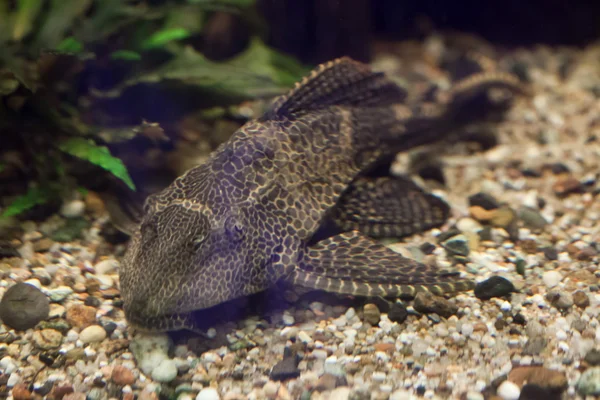
9. Roseline Sharks
Roseline Sharks (Sahyadria denisonii) or Denison’s Barb is another cyprinid that is even more similar to rainbow fish in care needs. Roseline Sharks are surface feeders and are found in fast-moving mountain streams, just like rainbow fish.
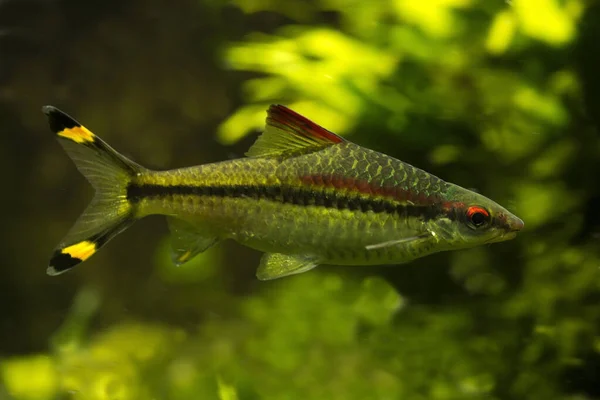
However, in their native Kerala, India, they are slowly becoming endangered due to local pollution and demand from pet stores. Fortunately, you can help by captive breeding these fish. The demand for captive-bred Roseline Sharks is huge. And so long as you provide a large tank with plenty of water flow, they will live alongside rainbow fish very easily!
10. Angelfish
Angelfish are a medium-sized cichlid from South America that gets its name from its elegant appearance. Angelfish can live alone but prefer being kept in small groups of 4 to 6 individuals alongside peaceful tank mates like rainbow fish.

Angelfish do prefer tall plants like Vallisneria and Amazon Swords to swim among. They will also deposit their eggs on these live plants. But unlike other cichlids, Angelfish are very mild-mannered and won’t harm the other fish species in your aquarium.
11. Gouramis
Gourami are a large category of fish that includes the small Dwarf Gourami and the massive Giant Gouramy. The majority are medium-sized fish ranging from 2 to 6 inches long that swim slowly and mostly keep to themselves.
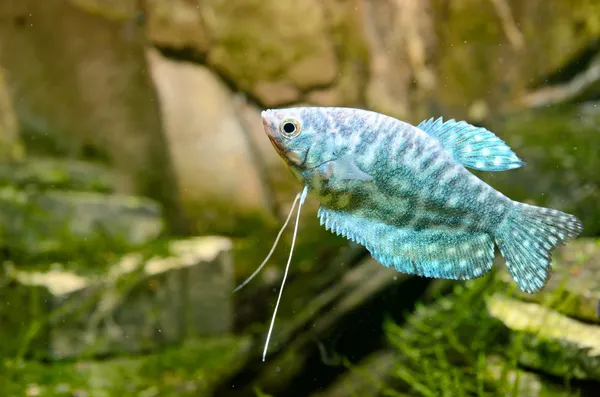
A few can be semi-aggressive, including Blue Gouramis and Kissing Gouramis. However, they don’t have teeth and are far too slow to be a dangerous tank mate to a school of rainbow fish. Gouramis are closely related to betta fish. They also build bubble nests and care for their young, just like bettas do!
12. Clown Loach
The Clown Loach is another native of Southeast Asia that your local pet store likely has in stock. They are one of the more brightly colored and active bottom-dwelling fish out there, moving fast and in small schools.
Clown Loaches are very cute when young. But be aware that they grow to be 8 to 12 inches long and need their own company. So aquariums 75 gallons or larger are required to keep them as adults. However, they are peaceful and eagerly eat anything from tropical flakes to soft plants. But they love snails and worms more than anything!
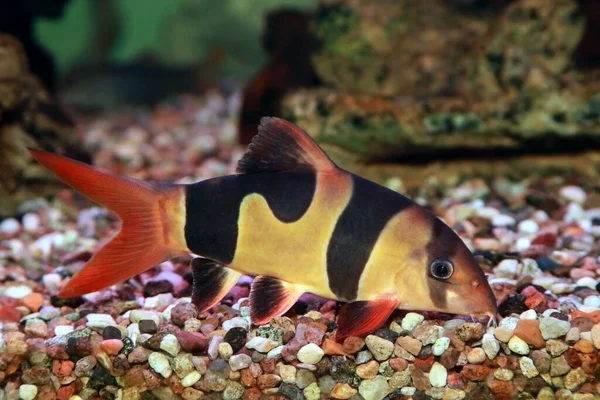
Other Rainbowfish Species
Rainbow fish care is broadly similar – all of these fish enjoy good water quality with a moderate pH and high oxygen levels. Temperatures should also be moderate (73-78°F), and I recommend occasionally feeding them live foods, which contain carotenoids and other color-enhancing pigments.

You can even mix and match rainbow fish species so long as you choose fairly similar fish in size. For example, a male Red Rainbow fish (up to 8 inches long) is many times larger than a Pygmy Rainbow fish (2 inches maximum). Rainbow fish are also great fish for planted fish tanks since they won’t eat plants and even use them for spawning!
13. Dwarf Shrimp
Dwarf shrimp includes Cherry Shrimp, Bee Shrimp, and other small freshwater species. Only smaller rainbow fish are a good match to shrimp since the larger species will gladly eat them.
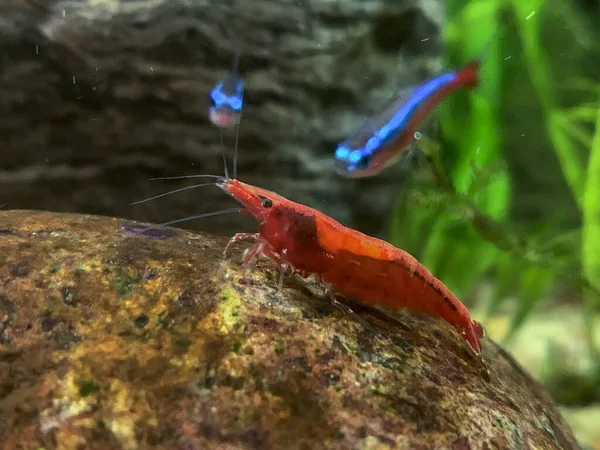
Shrimp can be a little sensitive to dissolved waste products, especially ammonia. So your water quality needs to be excellent. However, they tend to breed easily once they’ve settled into a mature tank, especially Cherry Shrimp!
14. Tetras
Tetras are the South American analogue to Rainbow fish. From the ever-popular Neon Tetra (Paracheirodon innesi) to the unusual Blind Cave Tetra (Astyanax mexicanus), Tetras come in an infinite array of colors and sizes.

They are fast-moving fish that need to be kept in schools of at least six individuals, if not more. Tetras are not difficult to care for, but they are a little sensitive to high levels of ammonia, nitrite, or nitrate. Most also appreciate soft, acidic water conditions. So make sure your tank is fully cycled, and the water parameters are healthy before adding a school!
15. Dwarf Otocinclus
If you are looking for an algae eater that remains small, Dwarf Otocinclus are hard to beat. Otos live in huge schools in the Amazon River, moving in swarms to feed on patches of algae on hard surfaces. So they enjoy their own kind and have an endless appetite for greenery. However, they are delicate cleaners and won’t damage even soft plants like Cabomba!

16. Corydoras
Corydoras are small schooling catfish that live along the bottom of the tank. Unlike many catfish, corydoras are fast and active during the day. They will even eat near the surface with the other fish in the tank! Corydoras aren’t known for being brightly colored. But the way they chase each other and dash around the tank makes them excellent tank mates for rainbow fish!

17. Betta Fish
Many people think that Betta fish have to be kept alone because they are too aggressive. In fact, they are only super aggressive towards each other. Bettas can be kept with other species of fish so long as they don’t have similar colors and fin shapes (Guppies are a poor match to Bettas).
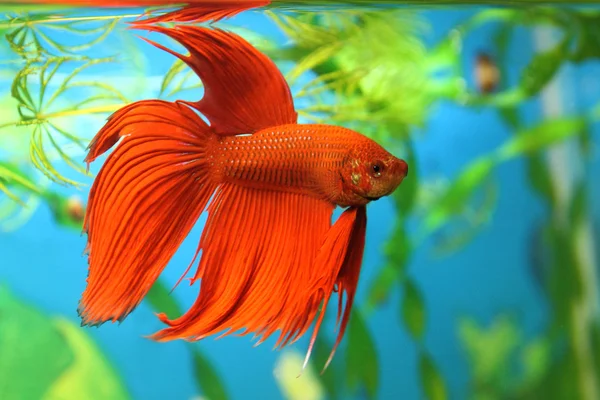
Bettas are also very hardy and slow-moving, offsetting the habits of the speedier rainbow fish. Offer frozen or live food as an occasional betta treat, and you will get much better color out of your fish!
18. Kuhli Loach
Unlike other species of loach, the Kuhli Loach has a worm-like body. It spends much of its time digging for worms and other small invertebrates. They especially love being kept in planted fish tanks with a soft, sandy bottom for them to explore.
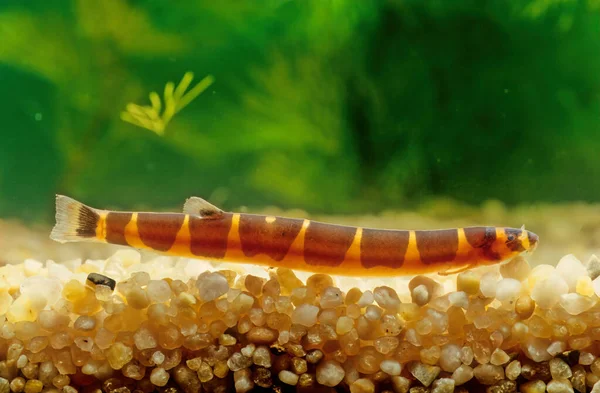
Kuhli Loaches are very peaceful and occasionally breed when given ample frozen food and plenty of plants to hide among. And since they live along the bottom, they never come into conflict with rainbow fish!
19. Hatchetfish
Last on our list is the Hatchetfish. These are characins and thus closely related to Tetras. Hatchetfish live along the surface and are constantly on the lookout for aquatic insects and their larvae.
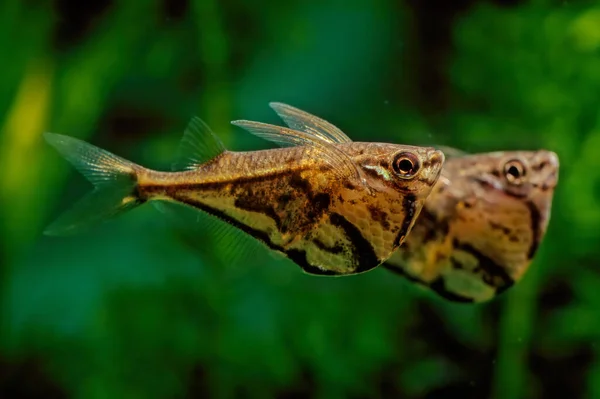
Hatchetfish are skittish and are extremely good jumpers. So I recommend keeping plenty of floating plants in their tank, so they are less likely to leap if startled.
Wrapping Things Up
Rainbow fish are well worth a look if you are unfamiliar with them. Most are eyecatching fish that look amazing in a school. They rarely catch most of the common disease types out there and will eat just about anything you offer. And, as this list shows, rainbow fish get along with a wide range of other aquarium fish species!

